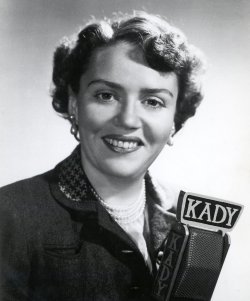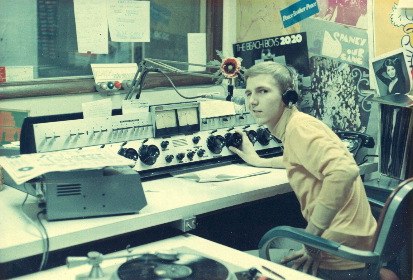Radio Articles
One Woman – Many Names

Sheila Moseley had a long career in broadcasting, and she can thank the Philomathians for getting her started.
Working under the various names of Shila (pronounced SHY la) Shelp, Sheila Graham, Sheila Moseley, Nancy Willard and Nancy Dixon, her work in St. Louis covered many duties on several radio and television stations and hundreds of broadcast advertisements.
Her first appearance on radio here came after a series of developments that appeared on the surface to be unrelated. She came home in the summer of 1941 after her freshman year at Smith College, where they were building a radio station. Her mother, who had been taking a writing course here at Washington University, had written a 15 minute play that was to be broadcast on KFUO. Sheila’s father decided she wouldn’t be going back to school in the Fall because he believed the United States would soon be involved in war.
So Sheila went to the Concordia campus, which was the home of KFUO. New studios were being built, and the play was being broadcast from the robbing room of the chapel. After hearing her performance, station manager Rev. Elmer Knoernschild asked her to join the Philomathians, his radio drama group. It was a large group of actors and actresses who did dramas on KFUO each Saturday evening. “One time we ran out of material, so the station held a competition for writers,” Mrs. Moseley recalls “The top three submissions would be performed by the group. The winner was a young man named Rod Serling.
“Elmer later asked me to do the ‘Little Red Schoolhouse’ show for him, and I got paid for that. I also did ‘Through the Museum Doors’ which I had to write as well. I remember the day Pearl Harbor was attacked. I made my way to KFUO to see what I could do to help. Elmer was doing the announcing and getting information from wire copy. I answered phones.”
Her first job that really paid was a direct outgrowth of the Philomathians. She worked as an actress on a couple episodes of the “Land We Live In,” the Union Electric weekly drama on KMOX. (In the 1950s, she was a regular actress on the program on KSD.) She also did voice work on WEW and the “Mary Lee Taylor Show,” a national production of Gardner Advertising for their client, Pet Milk.
Behind the scenes, Sheila was making things happen too. At WEW in the early ‘40s, she was paid a starting salary of $15 a week as music director, choosing the selections to be played on the air. Unable to get a pay increase there, she moved to KXOK, where manager Chet Thomas paid her $22.50 to write scripts in the continuity department. She remembers “There were lots of complaints there from advertisers about Harry Caray’s reading of commercials. He was not an easy man to work with.
“In 1943, Harry wanted to get rid of France Laux, another sports voice on KXOK, so he went to Chet Thomas and persuaded him to broadcast Harry’s ticker tape broadcasts of the out-of-town games. Harry would really dress these up and France, whose personality wasn’t that appealing, finally left. I don’t think he ever knew how Harry set that up.”
The KXOK studios were on the mezzanine level of the Star-Times Building, and working conditions in the summer were very uncomfortable. “It was extremely hot. Back then, every word that was uttered on the air had to be written by the continuity department. We worked with the windows open and electric fans blowing, and if we didn’t put something down to anchor the paper, scripts would go flying out the window.”
The chance for upward mobility came in the form of a job offer – news writer and reader – from news director Harry Renfro. She turned it down at the insistence of her father. “He didn’t like the idea of me working with the newsmen.” Later she did combine with Jerry Burns for a daily sports show using the name Shila Shelp. In 1949 she returned to KXOK after an absence of several years and became the music director for popular disc jockey Hal Fredricks. “I worked with him for six months getting his music together and writing all his intros and ad libs.”
Along the way Sheila married Harman Moseley. Between 1951 and 1956 she was the host of “The Nancy Dixon Show,” a national franchise program on KSD sponsored by Cluett-Peabody’s “Sanforized” division. The program, she says, was a 15 minute commercial for the process that prevented clothes from shrinking, and it gave her a chance to spotlight local stores and do features.
Sheila and her husband moved out of the market then to pursue a business venture in Arkansas. When they returned she began a 15 year stint in the local Pulitzer broadcast operation doing vacation fill-in, which gave her a chance to do just about every job in the building, including producing Russ David’s “Playhouse Party” There was also a five-year run at WIL during that same time in which she was “Nancy Willard” doing several women’s programs on the air.
Sheila Moseley capped her broadcast career here with a short appearance on KADY, a station partly owned by her husband, and several years working as free-lance commercial voiceover talent.
(Reprinted with permission of the St. Louis Journalism Review. Originally published 02/2004)

